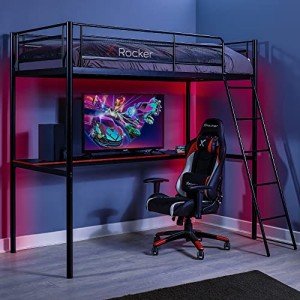A Provocative Remark About Bunk Beds For Kids
Bunk Beds for Kids: A Comprehensive Guide
Bunk beds have actually been a popular option for children's bedrooms for many years. They use a space-saving service that makes the most of floor area, offers enjoyable climbing up choices, and is available in a range of designs that appeal to children's creativities. This post checks out the benefits, factors to consider, designs, and security functions related to bunk beds for kids.
Advantages of Bunk Beds
Bunk beds present multiple advantages that make them an appealing option for households. Here are some essential advantages:
Space Saving
- Bunk beds allow two or more children to share a room without compromising space for play or other activities.
Economical
- Buying a single bunk bed can be more affordable than buying two separate beds.
Fun Factor
- Kids typically see bunk beds as a fun location to sleep and play, cultivating a sense of experience.
Flexibility
- Bunk beds are readily available in various setups, including L-shaped, loft beds, and even convertible styles that can alter as children grow.
Organization
- Lots of bunk beds come with integrated storage alternatives, such as shelves and drawers, helping keep spaces arranged.
Key Considerations Before Purchasing
Before investing in a bunk bed, it's necessary to think about specific factors, such as:
Space Requirements
Step the space to make sure that there suffices vertical space, permitting adequate headroom on the leading bunk.Age of Your Children
Consider their age and maturity. Numerous manufacturers suggest that kids under six ought to not sleep in the top bunk due to security concerns.Weight Limit
It's important to inspect the weight limits of the bunk bed for both the leading and bottom bunks to make sure safety.Style Preferences
Choose a style that matches the room's decoration and the kids's choices.Product
Bunk beds are readily available in various products, such as wood or metal. Each has its benefits and disadvantages regarding durability and looks.
Styles of Bunk Beds
Bunk beds come in different designs to fit different aesthetic appeals and functional needs. Here's a list of some popular styles:
Standard Bunk Beds
Traditional stacked beds that consist of two beds constructed one above the other.Loft Beds
A bed raised high off the ground, with space beneath for a desk, play location, or storage.L-Shaped Bunk Beds
Two beds arranged in an L-shape, providing more floor space and an unique style aspect.Twin Over Full Bunk Beds
These alternatives include a twin bed on leading and a full-sized bed on the bottom, accommodating older children or adults.Triple Bunk Beds
Designed for 3 children, these beds usually consist of three stacked beds, ideal for bigger families.
Security Features to Consider
Ensuring the security of kids using bunk beds is paramount. Here are some safety includes to search for before making a purchase:
Guardrails
A bunk bed should include durable guardrails on the top bunk to avoid accidental falls.Ladders
Guarantee that the ladder is securely attached and easy for children to navigate securely.Stability
Try to find bunk beds with lower center of mass and large bases to provide much better stability.Quality Construction
Pick beds made from long lasting materials that meet security standards, such as ASTM (American Society for Testing and Materials) regulations.
Frequently Asked Questions About Bunk Beds
1. What age is appropriate for a top bunk?Generally, bunkbedsstore aged 6 and older are suggested for oversleeping the top bunk. 2. Are bunk beds safe for toddlers?Most specialists advise against
positioning toddlers in the leading bunk due to the
threat of falls and improper ladder usage. 3. Can bunk beds be separated?Many bunk beds are designed to be separated into two standalone beds,
supplying added versatility as children grow
. 4. How do I keep a bunk bed?Regularly look for loose screws and wear, keep mattresses clean, and guarantee that the bunk bed is
steady to lengthen its life expectancy. 5.
Exist any unique bed mattress requirements for bunk beds?Yes, mattresses for bunk beds need to fit comfortably without leaving gaps. Usually, thinner mattresses
**(around 6 to 8 inches )are recommended for leading bunks for security. Bunk beds offer a flexible, useful, and enjoyable solution for kids's sleeping arrangements, optimizing space while accommodating numerous kids in one room. By thinking about the important aspects
of style, security, and space, parents can make an informed decision when selecting the ideal bunk bed for their kids's needs. With the right care and upkeep, a bunk bed can be a cherished piece of furnishings that provides years of use and pleasure for kids. Summary Table of Bunk Bed Styles Style Description Best For Requirement Bunk Beds Traditional design, 2 stacked beds Smaller rooms Loft Beds Raised bed with open space underneath Research study or play areas L-Shaped Bunk Beds 2 beds in an L-shape
- * *
Added flooring space Twin Over Full Twin on leading,
full on bottom Accommodating older children Triple
Bunk Beds
Three stacked beds
Larger families By comprehending
**the numerous choices available, designated factors to consider for security and performance, and proper age standards, households
**can select the best bunk bed that not
just improves their living space
but also ensures a safe and
**
**
**pleasurable sleeping environment
for their children.  ****
****